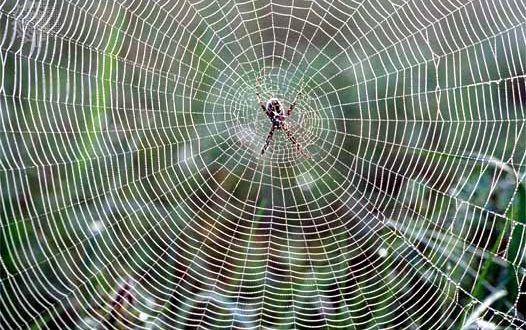Inspired by spider’s silk, the new liquid wire material acts both solid and liquid. It extends like solid and compress like a liquid.
Pulling on a sticky thread in a garden spider’s orb web and letting it snap back reveals that the thread never sags but always stays taut – even when stretched to many times its original length. This is because any loose thread is immediately spooled inside the tiny droplets of watery glue that coat and surround the core gossamer fibres of the web’s capture spiral.
The scientists studied the details of this ‘liquid wire’ technique in spiders’ webs and used it to create composite fibres in the laboratory which, just like the spider’s capture silk, extend like a solid and compress like a liquid. These novel insights may lead to new bio-inspired technology.
Professor Fritz Vollrath of the Oxford Silk Group in the Department of Zoology at Oxford University said: ‘The thousands of tiny droplets of glue that cover the capture spiral of the spider’s orb web do much more than make the silk sticky and catch the fly. Surprisingly, each drop packs enough punch in its watery skins to reel in loose bits of thread. And this winching behaviour is used to excellent effect to keep the threads tight at all times, as we can all observe and test in the webs in our gardens.’
The novel properties observed and analysed by the scientists rely on a subtle balance between fibre elasticity and droplet surface tension. Importantly, the team was also able to recreate this technique in the laboratory using oil droplets on a plastic filament. And this artificial system behaved just like the spider’s natural winch silk, with spools of filament reeling and unreeling inside the oil droplets as the thread extended and contracted.
Dr Hervé Elettro, the first author and a doctoral researcher at Institut Jean Le Rond D’Alembert, Université Pierre et Marie Curie, Paris, said: ‘Spider silk has been known to be an extraordinary material for around 40 years, but it continues to amaze us. While the web is simply a high-tech trap from the spider’s point of view, its properties have a huge amount to offer the worlds of materials, engineering and medicine.
‘Our bio-inspired hybrid threads could be manufactured from virtually any components. These new insights could lead to a wide range of applications, such as microfabrication of complex structures, reversible micro-motors, or self-tensioned stretchable systems.’
Agencies/Canadajournal
 Canada Journal – News of the World Articles and videos to bring you the biggest Canadian news stories from across the country every day
Canada Journal – News of the World Articles and videos to bring you the biggest Canadian news stories from across the country every day



